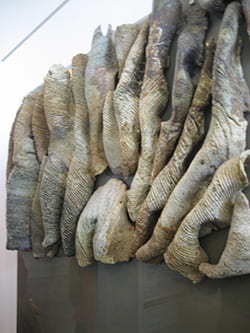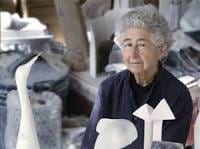Ruth Duckworth explored the environmental condition of our planet. In a biographical documentary, Duckworth said, “My garden, my environmental magazines, using my eyes as I travel round the world…it’s nature basically. Nature is very sexy; we didn’t invent that.” She closely inspected the world and traveled frequently, finding the peculiarities of nature dramatic and worthy of investigation. She rarely repeated forms, preferring to iterate and experiment. A tiny seed-pod from her garden was one of her favorite forms, from which she made many pieces. She was also fascinated with the grandeur of earth as seen from space. For the large project Earth Water Sky (1964), in the entrance to the Hinds Laboratory at UChicago, she studied some of the first published images of the earth as seen from the Mariner 9 satellite during its voyage to orbit around Mars.
Accompanying Duckworth’s awe for nature was her concern for human exploitation of the earth. During her working years, the environmental movement raised awareness of the earth’s fragile ecosystems. In 1962 scientist Charles David Keeling identified rising CO2 concentrations. The first Earth Day was held in 1970 and the first United Nations environmental conference was held in 1972. At the same time, new photos of earth from space showed its green-blue, watery surface as a beautiful ball. Just as we began to understand the artistic and scientific grandeur of Earth, and perhaps as a result, we discovered the harm caused by our exploitation of its resources. Duckworth felt this duality deeply and expressed it in her work.
Her reverence for our world was only eclipsed by her concern for our future. In an interview for the 1994 edition of Art Journal, Duckworth said that which “is truly important is the survival of the planet. These ecological issues feel very large for me.” She explained that later in life she believed her work was of decreasing value in comparison to the vital efforts required to prevent the impending demise of our planet. Her work, in essence, became a form of human self-centeredness in the face of nature’s grandeur.
This tension between the human and the natural is acute in Untitled (1972). The stoneware cylinders look ancient like petrified roots or bones, contrasting dramatically with the modern, clean plexiglass backing. Plexiglass is a modern material and decidedly non-organic. Its synthetic character clashes with the organic material and form of the stoneware. The broken edges of the cylinders make this dialog between natural and artificial violent and argumentative. The cylinders seem to be broken parts of an ancient whole.
Duckworth’s method mimicked the organic world from which she drew inspiration. She strove to remove rational, logical thought while sculpting in favor of instinct and spontaneity. Duckworth said, “When I am working, I try not to think, I may have feelings, I may have something going on, I mean I am bound to have something going on, but I don’t want to think, I want it to happen by itself, I want it to flow up by itself and not interfere with it. When I have a break, I start thinking, you know, I wonder what I’ve got there.” In Untitled (1972), Duckworth did not make decisions according to prior reasoning, she made forms with uninterrupted action. This 1972 piece is likely a collage of elements, each an individual study in the organic. In short, for Duckworth, Untitled (1972) was an assemblage of processes.
As viewers, we benefit from understanding this spontaneous, non-rational philosophy. Untitled (1972) can be considered from an ecological perspective, but a subjective experience is just as enriching. Duckworth herself wanted to avoid imposing the curator or historicist’s interpretation: it is important when viewing works like Untitled, in Duckworth’s words, to “not sit on yourself, and watch everything…let things come up.”
Written by Innis Gallagher, Student in the College


